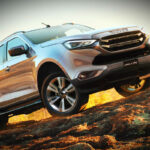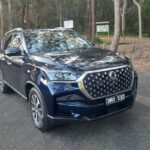
While North Korea is intent on firing missiles across the bows of any foreign nation state within range, neighbouring South Korea goes on capturing hearts and minds worldwide with quality products.
The latter is no better represented than by the third generation Hyundai i30 hatch recently arrived in Australia.
The six-time Australia’s Best Car winner comes with plenty of standard features and the new model has LED headlamps, wireless smartphone charging, heated and ventilated front seats, and more.
The entry-level Active sets the value-for-money trend at $20,950; runs through to Elite, Premium, SR and SR Premium.
Alloy wheels debut as standard across the i30 range, with 16 and 17-inch alloys on Active, Elite and Premium and 18s on sports variants SR and SR Premium. On test was the range-topping SR Premium, selling for $33,950, plus on-road costs.
STYLING
The new Hyundai i30 has the latest version of Hyundai’s so-called Fluidic Sculpture styling and uses a new version of the company’s signature grille. We are told this is designed to represent the flow of molten steel.
The grille is piano black with a contrasting chrome surround. In Elite, Premium and SR variants it incorporates chrome-plated dots and a satin chrome surround.
A long bonnet is reinforced by a line running from the headlights to the Hyundai Tucson-style tailgate. A roof-mounted shark-fin antenna and swept-back roof spoiler add a look of prestige. There are machine-faced wheels for Elite and Premium, and sporty twin-spoke 18s on the SR and SR Premium variants. The latter two have twin exhaust tips in the blacked-out rear lower area.
INTERIOR
The sporting flavour of the SR Premium exterior is extended to the passenger cabin with exclusive sports front seats with extended bolsters offering greater lateral support.
A rather sombre black colour scheme is lightened somewhat by contrasting red stitching on the seats, red trim highlights and distinctive red seatbelts.
INFOTAINMENT
The 8.0-inch tablet-style multimedia display, mounted high on the dashboard, is within reach of both driver and front passenger.
The so-called Supervision dash has a 4.2-inch colour TFT LCD display, which displays a range of trip computer information, as well as system status and visual alerts from SmartSense and other safety systems.
It can also show turn-by-turn directions from the on-board satellite navigation. Supervision cluster is standard on SR, SR Premium, Elite, and Premium models.
Hyundai recently launched a world-first smartphone app that helps new i30 owners become better drivers.
Standard on all new i30 variants, Hyundai Auto Link connects the car’s computer to a mobile phone via Bluetooth, keeping track of the car’s performance and providing analytical information.
Included is general driving information, parking management, driving statistics (fuel consumption and speed pattern), vehicle health check and report, message box and present or requested location on a map.
ENGINES / TRANSMISSIONS
Exclusive to i30 SR Premium is Hyundai’s 150 kW / 265 Nm 1.6-litre turbo-petrol engine mated with a seven-speed DCT transmission, incorporating steering wheel-mounted shift paddles.
SAFETY
For the first time, the new i30 carries Hyundai’s comprehensive SmartSense driver assistance package offering significant passive and active safety technology upgrades.
These include autonomous emergency braking and forward collision warning, blind spot detection with lane change assist, driver attention alert, lane keeping assist and rear cross-traffic alert. Smart cruise control and emergency stop signal are also in the mix.
Also across the new Hyundai i30 range is electronic stability control, which includes traction control, anti-lock braking with electronic brake-force distribution, brake assist and hill-start assist.
The rear-view camera has guidelines and is complemented by sensors. The i30 Premium adds four-sensor front park assist.
Seven airbags include driver and passenger airbags, front side (thorax) airbags, full-length side curtain airbags and driver’s knee airbag.
DRIVING
Settling into the sports seats of an SR automatic resulted in the satisfaction of the i30’s promotion to the premier league of sporty hatchbacks to the accompaniment of a distinctive rorty (some may say harsh) note in keeping with its premium performance credentials.
The new i30’s on-road dynamics have benefitted from exhaustive testing and development for local conditions and driver preferences by Hyundai Motor Company Australia’s highly credentialed chassis development team and it shows.
Add to this greater use of lightweight high-strength steel, which has increased body rigidity over the outgoing model while achieving a 28 kg lighter weight, and use of aeronautical industry-style structural adhesives, the i30 stability in handling and ride comfort was hard to fault in day-to-day driving.
The boot deserves credit too, with the SR Premium rigid floor’s ability to be positioned at two different heights. The lower mounting maximises the 395-litre cargo volume, while the upper height allows the rear seats to be folded completely flat.
SUMMING UP
It’s hard to imagine being in a vehicle so well presented, equipped and so well priced as the Hyundai i30 SR Premium. It seems, with its speedy run up the sales charts, the facts, however, have not gone unnoticed with buyers.
AT A GLANCE
MODEL RANGE
Hyundai i30 Active 2.0 GDi: $20,950 (manual), $23,250 (automatic)
Hyundai i30 Active 1.6 CRDi: $23,450 (manual), $25,950 (automatic)
Hyundai i30 Elite 1.6 CRDi: $28,950 (automatic)
Hyundai i30 Premium 1.6 CRDi: $33,950 (automatic)
Hyundai i30 SR 1.6 T-GDi: $25,950 (manual), $28,950 (automatic)
Hyundai i30 SR Premium 1.6 T-GDi: $33,950 (automatic)
Note: These prices do not include government or dealer delivery charges. Contact your local Hyundai dealer for drive-away prices.
SPECIFICATIONS (Hyundai i30 SR Premium 1.6-litre turbo-petrol 7sp auto five-door hatchback)
ENGINE:
Capacity: 1.591 litres
Configuration: Four cylinders in line
Maximum Power: 150 kW @ 6000 rpm
Maximum Torque: 265 Nm @ 1500-4500 rpm
Fuel Type: Petrol 91 RON
Combined Fuel Cycle (ADR 81/02): 7.5 L/100km
CO2 Emissions: 175 g/km
DRIVELINE: Seven-speed DCT automatic with sequential manual mode
DIMENSIONS, WEIGHT AND CAPACITIES:
Length: 4340 mm
Wheelbase: 2650 mm
Width: 1795 mm
Height: 1455 mm
Turning Circle: 10.6 metres
Kerb Mass: 1436 kg
Fuel Tank Capacity: 50 litres
BRAKES:
Front: Ventilated disc
Rear: Solid disc
STANDARD WARRANTY:
Five years / unlimited kilometres













